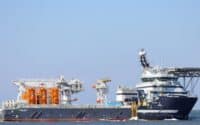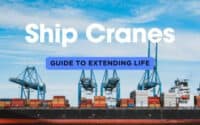Marine Cranes: Ultimate Guide
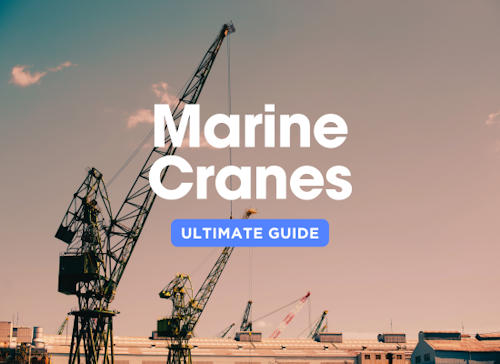
When it comes to equipping a ship with the right tools for cargo handling, cranes play a pivotal role in ensuring efficiency, safety, and versatility. With a wide variety of cranes available, each designed to meet specific operational needs, shipowners must navigate a complex landscape of options. Whether handling containers, bulk materials, or heavy lift operations, the right crane can significantly impact a ship's performance and profitability. This ultimate guide explores the top crane types that are essential for modern vessels, offering insights into their functionality, costs, and the pros and cons associated with each type.
| ShipUniverse: Top Cranes for Ships | ||||
|---|---|---|---|---|
| Crane Type | Function | Cost Range | Pros | Cons |
| Gantry Crane | Primarily used in ports for loading and unloading containers from ships. | $350K - $7M | High efficiency, capable of handling large container volumes, essential for container ships. | Expensive, requires significant space and infrastructure, limited to container handling. |
| Jib Crane | Used for general cargo handling, capable of rotating 360 degrees. | $210K - $1.4M | Versatile, ideal for various cargo types, compact design suitable for smaller vessels. | Limited lifting capacity compared to larger cranes, potential for slower operation. |
| Knuckle Boom Crane | Designed for confined spaces, the boom can fold to save space when not in use. | $350k - $2.1M | Compact, flexible operation, ideal for offshore support vessels. | More complex mechanics can lead to higher maintenance costs, lower lifting capacity. |
| Telescopic Boom Crane | Features an extendable boom, offering variable reach for different cargo operations. | $350k - $2.8M | Adjustable reach, suitable for varying cargo sizes, easy to operate. | More expensive than fixed-boom cranes, requires more maintenance. |
| Luffing Crane | Allows high-precision lifting by raising or lowering the jib. | $560k - $4.9M | High precision, essential for heavy-lift ships, adaptable for different cargo types. | High cost, complex operation, requires skilled operators. |
| Pedestal Crane | Mounted on a pedestal base, used for general cargo handling on various ships. | $140K - $700K | Stable, versatile, and suitable for multiple ship types. | Limited mobility, fixed position on deck. |
| Sheerlegs (Floating Crane) | Used for heavy lifting operations such as salvage or offshore construction. | $7M - $21M | High lifting capacity, crucial for heavy lifting and offshore work. | Very expensive, requires specialized crew and maintenance. |
| Grab Crane | Equipped with a grab for handling bulk materials like coal, ore, and grain. | $350k - $2.8M | Efficient for bulk material handling, durable design for tough operations. | Limited to bulk materials, less versatile for other cargo types. |
| Subsea Crane | Designed for underwater operations, often used in offshore oil and gas industries. | $10.5M - $28M | Critical for subsea operations, high precision and reliability. | Extremely expensive, requires specialized crew and maintenance. |
| Platform Crane | Used on offshore platforms for handling materials and equipment. | $1.4M - $4.2M | Essential for offshore platforms, durable for harsh environments. | High cost, limited to specific uses. |
| Lattice Boom Crane | Provides stable, heavy lifting, typically used in construction or salvage operations. | $700K - $4.9M | Stable, high lifting capacity, suitable for large ships. | Large footprint, not suitable for all ship types. |
| Portal Crane | Used in shipyards and ports for shipbuilding, repair, and cargo handling. | $700K - $2.8M | Versatile, can be used for shipbuilding and cargo operations, moves on rails. | Requires significant infrastructure, limited mobility. |
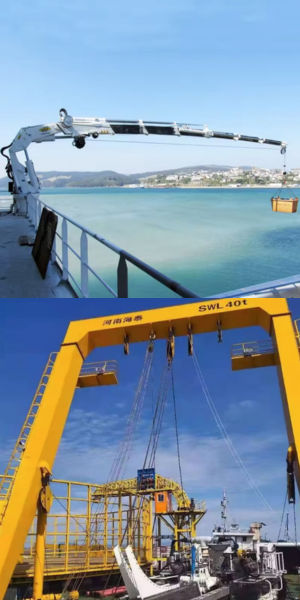
Factory Direct Pricing = Huge Savings
* High-end cranes trusted by top fleets.
* Fully customizable according to your specs.
* Marine cranes, including gantry, deck, knuckle boom, telescopic, and jib cranes, to meet all your maritime needs.
| Deck Crane | Gantry Crane | Overhead Crane | Container Carrier | Knuckle Boom |
|---|---|---|---|---|
| 10k to 80k | 20k to 50k | 30k to 60k | 40k to 70k | 15k to 40k |
Insider Tips
1. Gantry Crane
Overview:
Gantry cranes are a cornerstone in port operations, particularly for container handling. They are highly efficient, capable of moving large volumes of cargo swiftly and safely. Their towering structure and ability to traverse on rails make them indispensable for modern ports dealing with high container traffic.
Cost & Installation:
- Cost Range: $350K - $7M
- Installation: Installing a gantry crane requires significant infrastructure, including a robust rail system, a reliable power supply, and ample space. It’s often a major project that involves careful planning and coordination with port authorities.
Key Considerations:
- Port Infrastructure Compatibility: Ensure the port’s existing infrastructure, including rail and power, can support the gantry crane's size and operational needs.
- Automated Operations: Consider investing in a crane that can be upgraded to or already includes automation features, which can drastically reduce long-term operational costs.
- Weather-Resistant Customization: For ports in harsh weather conditions, opt for weather-resistant materials and reinforced structures to enhance the crane's durability.
- Efficiency with Twin-Lift Feature: If your operations involve high container throughput, a twin-lift capable crane can double efficiency by lifting two containers at once.
2. Jib Crane
Overview:
Jib cranes are versatile and commonly used for general cargo handling on ships. Their ability to rotate 360 degrees allows for flexible operation, making them ideal for various cargo types. Compact and effective, they are often found on smaller vessels or in locations where space is a premium.
Cost & Installation:
- Cost Range: $210K - $1.4M
- Installation: Jib cranes are relatively easier to install compared to larger cranes. Placement is crucial, as it determines the crane’s reach and utility. The installation involves anchoring the crane securely to the deck and ensuring that the rotation mechanism operates smoothly.
Key Considerations:
- Strategic Placement: Position the jib crane where it can cover the maximum deck area without obstruction, maximizing its efficiency.
- Rotational Precision: Ensure the crane offers precise rotation, which is essential for handling delicate cargo and operating in tight spaces.
- Maintenance Focus: Regular greasing of pivot points is necessary to prevent mechanical stiffness, especially in salty environments.
- Boom Length Customization: Tailor the boom length to your specific cargo needs, balancing reach with operational space constraints.
3. Knuckle Boom Crane
Overview:
Knuckle boom cranes are particularly valued for their compact design and versatility. The folding boom makes them ideal for operations in confined spaces, such as on offshore support vessels. Their flexibility allows for a wide range of lifting tasks, making them a popular choice for various maritime applications.
Cost & Installation:
- Cost Range: $350K - $2.1M
- Installation: Installation involves ensuring that the crane’s hydraulic systems are properly integrated into the ship’s existing systems. Special attention must be paid to the crane’s folding mechanism to ensure it operates smoothly.
Key Considerations:
- Maximizing Space Efficiency: The folding mechanism is perfect for space-saving, but it requires proper training for the crew to operate without causing wear on the hydraulics.
- Offshore Adaptations: For offshore use, invest in cranes with advanced stabilization features and hydraulic dampening systems to handle rough seas effectively.
- Maintenance Savings: Self-lubricating bearings can reduce maintenance needs, making these cranes ideal for vessels that operate far from port facilities.
- Optimal Lift Angles: Training operators to use the crane at optimal angles can improve lifting efficiency and reduce mechanical stress on the equipment.
4. Telescopic Boom Crane
Overview:
Telescopic boom cranes are highly adaptable due to their extendable boom, which offers variable reach for different cargo operations. This flexibility makes them suitable for vessels handling various cargo types and sizes, from small packages to large, bulky items.
Cost & Installation:
- Cost Range: $350K - $2.8M
- Installation: Installing a telescopic boom crane requires precise calibration of the extending and retracting mechanisms. Integration with the ship’s control systems is crucial to ensure smooth operation and to avoid any disruptions during cargo handling.
Key Considerations:
- Adjustable Reach: The crane’s extendable boom allows for customized reach, making it suitable for operations that require different lifting ranges. Ensure your crew is trained to utilize the adjustable boom effectively.
- Enhanced Stability: Given the variable reach, it’s important to invest in a crane with enhanced stability features to prevent tipping or imbalance when the boom is fully extended.
- Ease of Maintenance: Regular inspection and lubrication of the telescopic mechanisms are essential to prevent wear and tear. Choose cranes with easy access to these components for straightforward maintenance.
- Integration with Digital Controls: Consider cranes that can integrate with your ship's digital control systems for precision handling and monitoring, especially during complex loading operations.
5. Luffing Crane
Overview:
Luffing cranes are designed for precision lifting, allowing the boom to raise and lower, making them ideal for ships that handle heavy, awkwardly shaped loads. Their ability to adjust the boom angle makes them versatile in various operational scenarios, especially where space is limited.
Cost & Installation:
- Cost Range: $560K - $4.9M
- Installation: The installation of a luffing crane involves ensuring that the crane’s pivot points and hydraulic systems are robust enough to handle the additional stress from the variable boom angles. Proper alignment and reinforcement of the mounting points are crucial.
Key Considerations:
- Precision Lifting: The key advantage of a luffing crane is its ability to precisely control the lifting and lowering of the boom. This is particularly useful for positioning heavy loads in tight or congested areas.
- Boom Angle Control: Operators need to be trained to adjust the boom angle efficiently, as improper use can lead to instability or accidents. Advanced training programs are recommended.
- Weight Distribution: Pay close attention to the weight distribution on the ship when using a luffing crane, especially when handling heavy cargo, to avoid tilting or listing.
- Hydraulic System Maintenance: The hydraulic systems that control the boom’s movement are vital. Regular checks and timely maintenance are essential to prevent malfunctions that could lead to costly delays or accidents.
6. Pedestal Crane
Overview:
Pedestal cranes are versatile and stable, mounted on a fixed pedestal base. They are commonly used on various ships for general cargo handling, offering a balance between reach and lifting capacity. Their fixed position provides a stable lifting platform, making them reliable in various sea conditions.
Cost & Installation:
- Cost Range: $140K - $700K
- Installation: Installation involves securely mounting the crane to the ship’s deck, ensuring that the pedestal is anchored in a way that can withstand the stresses of heavy lifting. The stability of the base is key to the crane’s performance.
Key Considerations:
- Strategic Deck Positioning: The effectiveness of a pedestal crane largely depends on its placement on the ship’s deck. Position it to maximize coverage without obstructing other deck operations.
- Stability Enhancements: Given that pedestal cranes are fixed, enhancing stability through structural reinforcements is important, especially on smaller vessels or those operating in rough seas.
- Maintenance Access: Ensure that the pedestal base has accessible points for routine inspections and maintenance. This will help in keeping the crane operational with minimal downtime.
- Load Capacity Awareness: Be aware of the crane’s load capacity and ensure that it aligns with your operational needs. Overloading can lead to structural damage, which is costly to repair and can compromise safety.
7. Sheerlegs (Floating Crane)
Overview:
Sheerlegs, or floating cranes, are specialized for heavy lifting operations, such as salvage, offshore construction, and port activities. These cranes are mounted on a barge or pontoon, giving them the mobility to move to different locations where their lifting power is needed.
Cost & Installation:
- Cost Range: $7M - $21M
- Installation: Since sheerlegs are typically mounted on a floating platform, the installation involves securing the crane to a stable base on the barge or pontoon. This base must be reinforced to handle extreme loads and maintain stability in various sea conditions.
Key Considerations:
- Mobility Advantage: The ability to move a sheerlegs crane to different locations is a major advantage. However, this mobility requires careful navigation planning, especially when moving the crane in rough seas.
- Stabilization Systems: Invest in advanced stabilization systems to maintain balance during heavy lifts. This is particularly important when lifting large loads in open water, where wave action can cause instability.
- Specialized Crew Training: Operating a sheerlegs crane requires a highly skilled crew trained in both crane operation and barge handling. Ensure your team is equipped to manage both aspects effectively.
- Regular Structural Inspections: The structure of the barge or pontoon must be regularly inspected for integrity, as the heavy loads can lead to stress fractures over time.
8. Grab Crane
Overview:
Grab cranes are equipped with a clamshell bucket designed for handling bulk materials such as coal, ore, and grain. They are commonly used in ports and on bulk carriers, offering an efficient solution for loading and unloading large quantities of loose materials.
Cost & Installation:
- Cost Range: $350K - $2.8M
- Installation: Installing a grab crane requires ensuring the crane’s mechanical systems are robust enough to handle continuous, repetitive operations. The clamshell bucket and its controls must be integrated with the ship’s existing systems for smooth operation.
Key Considerations:
- Bucket Size Optimization: Choose the right bucket size for your typical cargo. Larger buckets can move more material, but they require more power and can be less precise, while smaller buckets are better for detailed work but might slow down operations.
- Wear-Resistant Materials: The constant abrasion from handling bulk materials can wear down the crane’s bucket and mechanical parts. Opt for wear-resistant materials or coatings to prolong the lifespan of these components.
- Efficient Dust Control: Handling bulk materials often creates dust, which can be hazardous. Invest in dust suppression systems to improve safety and reduce environmental impact.
- Automation Options: Consider automation upgrades for repetitive bulk handling tasks. Automated grab cranes can significantly reduce the need for manual intervention, increasing efficiency and reducing labor costs.
9. Subsea Crane
Overview:
Subsea cranes are specialized for underwater operations, often used in offshore oil and gas industries. These cranes are engineered to perform precise lifting and placement of heavy equipment on the seabed, making them crucial for subsea installations and maintenance.
Cost & Installation:
- Cost Range: $10.5M - $28M
- Installation: Installing a subsea crane requires advanced integration with the ship’s systems, particularly the hydraulic and control systems. The installation also involves reinforcing the crane’s structure to withstand deep-sea pressures and environmental challenges.
Key Considerations:
- Advanced Positioning Systems: Subsea operations require precise positioning, so invest in cranes with advanced dynamic positioning systems to maintain stability and accuracy during underwater lifts.
- Pressure-Resistant Design: Ensure that the crane’s components are designed to withstand the high pressures encountered at depth. This includes reinforced hydraulics, pressure-resistant materials, and specialized seals.
- Remote Operation Capabilities: Subsea cranes often need to be operated remotely, so choosing a crane with reliable remote control systems is essential. This allows for safer and more precise operations.
- Regular Deep-Sea Maintenance: Subsea cranes require regular maintenance to ensure they remain operational in challenging environments. This includes frequent checks on the hydraulic systems, cables, and pressure seals.
10. Platform Crane
Overview:
Platform cranes are essential on offshore platforms, handling materials and equipment necessary for drilling, production, and maintenance operations. Their robust design and ability to operate in harsh environments make them indispensable for the offshore oil and gas industry.
Cost & Installation:
- Cost Range: $1.4M - $4.2M
- Installation: Installing a platform crane requires securing it to a reinforced base on the offshore structure. The installation process must account for the crane’s ability to withstand high winds, corrosive environments, and constant use.
Key Considerations:
- Corrosion-Resistant Materials: Offshore environments are highly corrosive due to saltwater exposure. Invest in cranes made from or coated with corrosion-resistant materials to extend their lifespan.
- Weather-Adapted Operations: Platform cranes must be capable of operating in extreme weather conditions. Look for cranes equipped with features such as wind speed monitoring and automatic shutdown systems to enhance safety.
- Maintenance Planning: Given the difficulty of accessing offshore platforms, plan for regular maintenance intervals and ensure that spare parts are readily available on-site to minimize downtime.
- Load Monitoring Systems: Integrate load monitoring systems to ensure that the crane operates within its safe lifting capacity, preventing accidents and extending the crane’s operational life.
11. Lattice Boom Crane
Overview:
Lattice boom cranes are known for their stability and high lifting capacity, making them ideal for heavy lifting tasks in shipbuilding, construction, and salvage operations. Their lattice structure reduces weight while maintaining strength, allowing for the lifting of large and heavy objects.
Cost & Installation:
- Cost Range: $700K - $4.9M
- Installation: Installing a lattice boom crane involves assembling the lattice sections on-site and ensuring the base is securely anchored. The installation process also requires precise calibration of the crane’s load-bearing components to handle heavy loads safely.
Key Considerations:
- Customizable Boom Length: The modular design of lattice boom cranes allows for customization of the boom length. This flexibility enables operators to tailor the crane to specific lifting requirements.
- Enhanced Stability: The lattice structure provides excellent stability, but it’s essential to ensure that the base and boom are properly aligned during installation to prevent tipping or structural failure.
- Detailed Assembly and Inspection: The assembly of the lattice boom requires attention to detail. Regular inspections of the boom’s connections and joints are necessary to ensure safety and prevent wear over time.
- Load Swing Control: Given the large loads these cranes can handle, it’s important to incorporate load swing control systems to prevent dangerous oscillations during lifting operations.
12. Portal Crane
Overview:
Portal cranes, also known as goliath cranes, are typically used in shipyards and ports for heavy lifting tasks such as shipbuilding, repair, and cargo handling. These cranes move on rails and are capable of lifting and moving massive loads across large areas.
Cost & Installation:
- Cost Range: $700K - $2.8M
- Installation: Portal cranes require substantial infrastructure, including the installation of rail systems and reinforced foundations. The crane itself is typically assembled on-site and requires precise alignment with the rails for smooth operation.
Key Considerations:
- Infrastructure Investment: The installation of a portal crane is a significant investment in infrastructure. Ensure that the rails are laid with precision and that the foundation can handle the weight and movement of the crane.
- Versatile Applications: Portal cranes are highly versatile and can be used for various applications beyond shipbuilding, such as heavy cargo handling and assembly operations. Consider your long-term operational needs when investing in this type of crane.
- Rail Maintenance: The rails on which the portal crane moves require regular maintenance to prevent wear and misalignment, which can cause operational delays or accidents.
- Safety Systems Integration: Given the large area covered by portal cranes, integrating advanced safety systems such as collision avoidance and load monitoring is crucial to prevent accidents and ensure smooth operations.
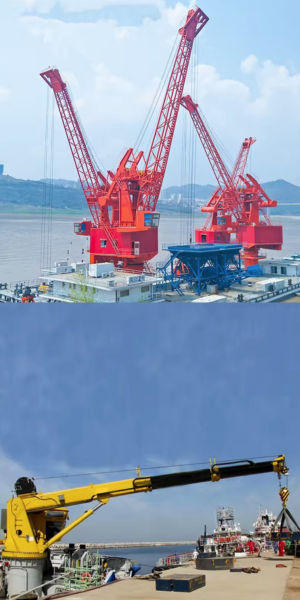
Factory Direct Pricing = Huge Savings
* High-end cranes trusted by top fleets.
* Fully customizable according to your specs.
* Marine cranes, including gantry, deck, knuckle boom, telescopic, and jib cranes, to meet all your maritime needs.
| Deck Crane | Gantry Crane | Overhead Crane | Container Carrier | Knuckle Boom |
|---|---|---|---|---|
| 10k to 80k | 20k to 180k | 3k to 10k | 100k to 260k | 15k to 100k |
Selecting the right crane for your ship or port operations is a critical decision that can impact efficiency, safety, and profitability. Each type of crane offers unique benefits tailored to specific needs, from the precision of a luffing crane to the heavy-duty capabilities of a lattice boom crane. By understanding the costs, installation requirements, and key operational considerations, you can make informed decisions that optimize your investment and enhance your operational capabilities. Whether you’re outfitting a new vessel or upgrading an existing fleet, this ultimate guide provides the insights needed to navigate the complex landscape of maritime cranes, ensuring that your operations are equipped to meet the demands of modern shipping and offshore industries.

Do you have a Maritime Product or Service that may be of interest to Shipowners? Tell us about it here!
Do you have feedback or insights? Please reach out to editor @ shipuniverse.com

